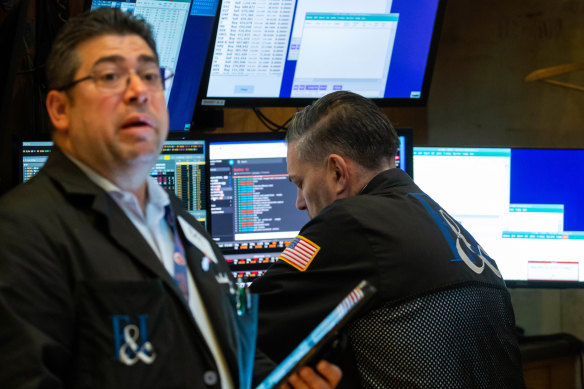Banks hit as ASX stumbles after Wall Street plunge
By Millie Muroi
The Australian sharemarket plunged on Friday as investors on Wall Street remained shaken over the prospect of more aggressive interest rate rises by the Federal Reserve in its bid to beat down inflation.
The S&P/ASX 200 was down 103.8 points, or 1.4 per cent, to 7,207.3 at the open as all sectors except utilities traded down.

Financials (down 2.2 per cent) fell across the board as Commonwealth Bank (down 2.5 per cent), NAB (down 2.4 per cent), ANZ (down 2.2 per cent) and Westpac (down 2.6 per cent) dragged down the local bourse. The energy sector (down 2 per cent) also spiralled down, weighed down by Woodside (down 2.3 per cent) and Santos (down 1.9 per cent).
Utilities (up 1.1 per cent) was the only sector in the green, as Origin Energy climbed 2.3 per cent. Resources companies including Northern Star (up 2.5 per cent), Yancoal (up 1.7 per cent) and Evolution Mining (up 1.1 per cent) also bucked the downward trend.
Meanwhile, stocks fell broadly on Wall Street and added to the week’s losses as markets remain anxious about the prospect of more aggressive action by the Federal Reserve to fight inflation.
The S&P 500 closed 1.9 per cent lower, the Dow Jones shed 1.7 per cent and the Nasdaq slumped by 2.1 per cent. All three indexes were higher earlier in the day.
The sharp drop follows two days of testimony before Congress by Fed Chair Jerome Powell, who said the central bank was prepared to continue making big interest rate increases if necessary. Fears about a persistently aggressive Fed have been weighing on major indexes, all of which are on track for weekly losses.
The Fed’s inflation-fighting policies risk slowing the economy too much and pushing it into a recession, while also going too far in softening a strong labor market and putting many people out of work.
A government report on Thursday showed that the number of Americans applying for unemployment benefits last week jumped by the most in five months, but layoffs remain historically low.
Yields on the two-year Treasury, which tends to track expectations for future Fed action, eased to 4.87 per cent from about 5.05 per cent just before the unemployment report’s release. It had been hovering at its highest level since 2007.
The unemployment data follows a report on Wednesday showing that the number of job openings advertised across the country last month was higher than economists expected. The US government’s more comprehensive report on hiring is scheduled for Friday.

A big concern within the labour market reports for the Fed and Wall Street is the pace of wage growth. Strong wage gains are good for workers struggling to keep up with high inflation, but it could also keep pushing inflation higher, making it harder for the central bank to fight high prices.
“It’s leading people to try and come to grips with what a stubbornly tight labor market means for economic growth as well as the inflationary environment,” said Keith Buchanan, portfolio manager at Globalt Investments.
Wall Street has been reviewing a range of data that has highlighted both a resilient economy and stubborn inflation. More updates are coming next week when the government releases reports on inflation at both the consumer and wholesale levels, along with retail sales data.
Traders are leaning toward the Fed raising its benchmark interest rate by 0.50 percentage points on March 22. They had been expecting the central bank to stick with a smaller increase of 0.25 points prior to Powell’s testimony this week, according to data from CME Group.
“The notion that was in back of minds of investors was that the worst of the tightening cycle was making its way into the rearview mirror and it would take a lot to re-accelerate tightening,” Buchanan said. “(Powell) put the re-acceleration back on the table.”
The Fed’s goal is to bring inflation down to 2 per cent. That figure stood at 5.4 per cent as of January. The central bank has already raised its key overnight rate to a range of 4.50 per cent to 4.75 per cent, up from virtually zero at the start of last year, its fastest set of hikes in decades.
With AP
The Market Recap newsletter is a wrap of the day’s trading. Get it each weekday afternoon.
Most Viewed in Business
Source: Thanks smh.com